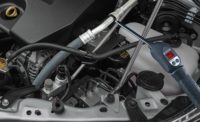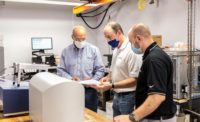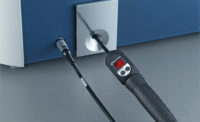The rapid and unexpected growth in the production of alternative drive systems is presenting automakers and their suppliers with a host of leak-detection challenges to ensure vehicle safety and quality.
New traction battery systems produced for battery electric vehicles (BEVs) and plug-in hybrid electric vehicles (PHEVs), for example, must be protected from water and humidity which can reduce battery life and cause fires.
Fuel-cell electric vehicles (FCEVs) also have unique leak-testing requirements, especially for hydrogen tanks, fuel cells and the batteries that drive electric motors.
EV Sales Are Growing by Leaps and Bounds
E-mobility quality-control challenges for carmakers are growing by leaps and bounds. Sales of plug-in EV sales last year alone jumped 40 percent globally to more than three million units. China and Europe accounted for 85 percent of the total compared to North America with 12 percent.
A recent survey by McKinsey & Co. and the World Economic Forum points to a major shift from combustion engines to electric drive systems for commercial vehicles. More than 70 percent of survey respondents also believed that electric powertrains represented the future for long-haul trucking and intracity transportation.
Dramatic reductions in the kilowatt-hour cost of battery-storage capacity are driving increased interest in electric vehicles as well. Ten years ago a kilowatt hour in the U.S. cost $1,100 compared to $156 or less today.
Leak Detection for EV Components is Required to Assure Quality and Safety
EV battery cells, battery packs, battery cooling circuits, electric motors and other systems modified for EV applications all require leak testing to assure both quality and safety.
Leak testing to make certain that battery-cell electrolyte does not leak out or come into contact with water during every stage of battery production is essential. Assuring the integrity of battery modules and battery-pack housings is equally important.
Leak-detection for fuel-cell electric vehicles that utilize hydrogen technology also is indispensable not only for hydrogen tanks, but also for the fuel cells and battery packs that supply power to their electric motors.
Since battery-cell electrolyte is highly flammable and can cause vehicle fires, reliable leak-testing is essential throughout the production process. Damage to battery cells also can occur while in transit to an OEM’s assembly plant. The “thermal runaway” of a single battery cell can cause burning electrolyte to reach temperatures up to 1,100 degrees centigrade. Because they represent a fire hazard, lithium-ion batteries, for example, can no longer be shipped on passenger planes.
Leak Testing Methods for Battery Cells
Tolerable leak-rate levels for battery cells depend on a variety of factors, including pressure conditions within the cell, the cell volume and its required service life. Today, many manufacturers expect a service life of up to 10 years or more. To achieve extended cell life, permissible leak rates for prismatic and cylindrical battery cells fall within a range of 10-5 to 10-6 mbar-l/s.
All battery cells need to be tested for large or so-called gross leaks, as well as for extremely small “capillary” leaks, which are difficult to detect.
Commonly used leak-detection methods such as pressure, helium bombing or visual inspection have proven to be either too slow or unreliable in catching small, but significant battery-cell leaks. (Problems associated with these methodologies along with new, more reliable test methods are discussed in a new e-book published by INFICON and available free of charge at https://bit.ly/3sdRKxq.)
New leak-detection systems based on mass-spectrometer technology now are capable of catching leaks 1,000 times smaller than previously possible. The new mass-spectrometer technology can detect all types of common electrolyte solvent, including DMC, EMC and PP. A flexible test chamber designed to prevent damage to pouch cells also has been developed to enable vacuum testing of pouch cells.
Leak Testing for Battery Pack Housings
Battery pack housings call for specific leak detection requirements since they protect battery modules and cells from water. Depending on where they are located, housings must meet IP67 or IP69K protection-class requirements.
Specific housing leak rates will depend on the material used for the housing. Aluminum has especially strict limits, while requirements for steel and plastic housings are less stringent.
Housings for electrical components such as lithium-ion batteries, power-control units, electric motors and electronic modules often are designed in accordance with IP67. (Testing according to IP67 requires that a component be fully functional after immersion in water at a depth of one meter for 30 minutes.)
The fastest and most accurate way to test components on the production line is to test for helium tracer gas in a vacuum chamber. Another option for testing both assembled and unassembled housings is an accumulation test which requires longer cycle times. Parts are placed in a simple accumulation chamber to determine if tracer gas is escaping from the test parts. Fans ensure escaping gas is evenly distributed in the chamber for detection by a stationary sensor.
Automated Robotic “Sniffer” Leak Detection
If a manufacturer wants to test the integrity of gaskets or seals on an already assembled battery pack, vacuum testing is not an option. Pressure differences with this type of testing might damage gaskets or destroy already-installed capacitors.
As an alternative, tracer-gas-based sniffer leak detection is recommended for battery packs and assembled housings. A “sniffer” leak detector probe is placed on a robot arm that travels along seals on the component or the test can be done manually.
Once battery packs have been assembled and tested, they still must be installed in an EV. Carmakers then will need to perform additional cooling-circuit tests to check connections to the system’s refrigerant circuit or test the cooling circuit for water-gylcol leakage.
Fuel Cell EVs and Their Components
Fuel cell electric vehicles (FCEVs) and electric-battery-powered vehicles share a number of components with similar leak-detection requirements. Both are driven by electric motors powered by lithium-ion batteries, although FCEV batteries are much smaller and have less storage capacity.
Fuel-cell vehicles, however, generate their own electrical energy and their fuel-cell stacks, high- and low-temperature cooling circuits, hydrogen tanks, lines and recirculation systems all must be leak tested.
A vacuum method is recommended for testing the bipolar plates within fuel-cell stacks for hydrogen leaks.
There are four common leak-related failures associated with fuel cells:- Loss of combustible hydrogen.
- Hydrogen leakage followed by an uncontrolled reaction with oxygen.
- Coolant leaks which affect efficiency and can damage the fuel-cell stack.
- Leakage of hydrogen into a cooling circuit which can affect efficiency and damage the circulation pump.
Hydrogen tanks installed in fuel-cell vehicles usually are made from composite materials and are capable of carrying large quantities of hydrogen gas. Typically, they can withstand operating pressures of up to 700 bar or 10,153 psi.
Vacuum leak testing with helium and accumulation testing with forming gas both are used to test hydrogen-tank bodies. Additional testing is required once the tank body is fitted with sensors as well as outlet and filling valves. The finished tank then is filled with tracer gas, sealed and robotically tested with a sniffer leak-detection probe.
Sensors and Electric Drive Motors
Whether it is a battery- or fuel-cell-driven EV, the vehicle’s sensors, control modules and electric drive motors all require some form of leak testing.
Water is the primary enemy of every vehicle’s electrical components. Water and humidity tightness, therefore, are critically important, especially for autonomous or Advanced Driver Autonomous Systems (ADAS).
Vehicle sensors often are tested with less sensitive, strongly temperature-dependent pressure decay tests. ADAS manufacturers, however, follow a zero-defect strategy that is a thousand times more reliable than a Six Sigma approach that tolerates 3.4 errors per million cases.
Sensors used for radar and lidar technologies not only must be water tight, but also gas tight—in other words completely sealed off from humidity. Instead of pressure-decay testing for these sensors, manufacturers rely on helium vacuum tests for leak rates in the range of 10-4 to 10-6 mbar-l/s.
Vehicles with an alternative drive system all are equipped with electric motors. Motor housings must be tested to make sure that water cannot enter from the outside and that their water-filled cooling jackets are leak proof as well.
Cooling circuits are designed for rapid heat transfer. Since pressure-decay testing is sensitive to fluctuations in temperature, vacuum testing with helium is more suitable for motor housings. Leak detection with a less expensive forming gas (5 percent hydrogen/95 percent nitrogen) also can be used.
Thomas Parker is responsible for INFICON’s automotive sales in North America and is considered an industry expert on leak testing automotive parts, systems and final vehicle assembly processes. He has been a featured speaker at numerous trade conferences on topics related to electric, fuel-cell and autonomous vehicles, including battery pack design and testing, battery-cell leak detection and leak detection for ADAS systems. INFICON has published a comprehensive 51-page guide to leak testing electric and fuel-cell vehicles which is available for download at https://bit.ly/3sdRKxq.








